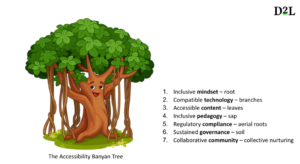As a child, I would sit beneath a banyan tree and climb its many spidering roots that descended toward the ground searching for soil to form new trunks. This is how the banyan tree grows—not so much up but out, reaching to new parts of its world, seeking to grow into its environment.
When I think about making learning more accessible, I think about the banyan tree. It prompts us to ask questions about our world so that we can better understand how best to grow and how to include more of the world within our ecosystem in a truly holistic manner. Just as a banyan tree’s strength comes from its naturally inclusive design, our collective success comes from making learning more accessible for everyone.
That’s why it helps to consider the elements of the banyan tree when considering how to build truly inclusive learning experiences. In emulating its structure, we can account for the key aspects of accessibility to help create more empathetic learning environments as well as more reflective and empathetic institutions and organizations as a whole. Making learning more inclusive creates understanding for all, not just some.
More from UB: The hybrid campus: Why colleges still need a physical presence in a virtual world
Seven key structures
Seven key structures of the banyan tree reflect critical aspects of accessibility implementation.
The root: An inclusive mindset
Like the roots of the banyan tree, accessibility in education must be grounded in empathy for human differences and the diverse needs that go with it. This is the strong foundation that feeds and upholds the entire education system.
Needs must be met in a personalized manner, with a focus on achieving equal outcomes and not just on providing equal resources. Designing and delivering education to meet the needs of learners with disabilities makes the experience better for all learners.
The branches: Compatible technology
Like the branches of the banyan tree, an accessible education system must provide strong support in all directions to learners who use assistive technologies by ensuring that those technologies work compatibly with the learning platform. This is achieved by ensuring that the learning platform is built in alignment with accessibility guidelines.
The leaves: Accessible content
Like the leaves of the banyan tree, pieces of learning content are constantly created anew and last for a while before being replaced. To remain usable by learners with disabilities, this content must be created and maintained in an accessible manner.
The sap: Inclusive pedagogy
Like the sap of the banyan tree that runs through it and enlivens it, pedagogy, or the mechanisms of delivery of education, ultimately gives life to the system and makes it real. Pedagogy must be intentionally inclusive in its curriculum, instruction and assessment to reach all learners.
The aerial roots (descending to the soil): Regulatory compliance
Like the aerial roots of the banyan tree, accessibility regulations help strengthen the education system through requirements that mandate action from the players in the system rather than leaving it to their choice. Compliance with regulations must be practiced with diligence following the spirit of the law and not just the letter of the law.
The soil: Sustained governance
Like the soil that nurtures the banyan tree, a structured accessibility governance system must be established and maintained to nurture the education system. This systemic support exists in the form of executive buy-in, policies and resources to feed the processes that are essential for the sustained practice of accessibility in education.
Collective nurturing: Collaborative community
Like tree roots in a forest that help care for one another through a connected network, education systems must remain connected and collaborate as a community to form an inclusive education ecosystem.
Remember, like a banyan tree, expanding accessibility in learning is about creating a holistic environment with a spirit of inclusivity at its core. Key to that growth is flexibility and empathy. No growing tree gets bigger or stronger simply by ticking off a series of steps or boxes. Still, the seven aspects that constitute successful accessibility implementation can be a helpful metric for success – and can help everyone stay mindful of practicing accessibility holistically to enable education to reach every learner. Be like the banyan!








